Easter Monday 1916
Posted by Jim on April 1, 2024

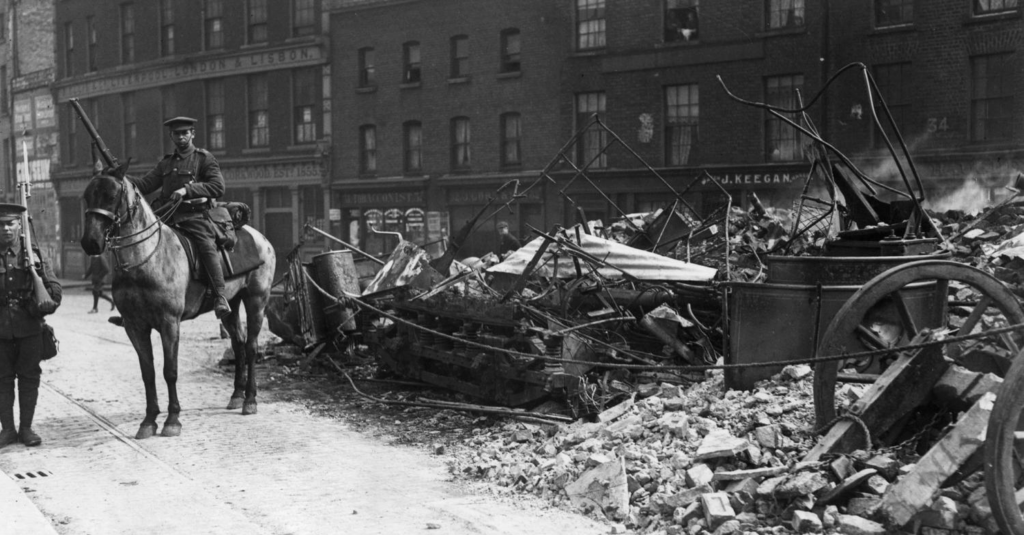
AOH Home of the Brooklyn Irish
Baile na nGael
Monday, April 29, 2024
Posted by Jim on

1916 Easter Rising: Background
With the Acts of Union in 1800 (ratified in 1801), Ireland (which had been under some form of English control since the 12th century) merged with Great Britain to form the United Kingdom of Great Britain and Ireland. As a result, Ireland lost its parliament in Dublin and was governed by a united parliament from Westminster in London. During the 19th century, groups of Irish nationalists opposed this arrangement in varying degrees.
Did you know? After the Easter Rising, one of the rebels, American-born Eamon de Valera, was sentenced to death. However, he ended up serving only a brief prison term and went on to become one of Ireland’s leading political figures, with a career spanning half a century.
Some moderate nationalists advocated for home rule, under which Ireland would remain part of the United Kingdom but also have some form of self-government. Several home rule bills were defeated in Parliament in the late 1800s before one finally passed in 1914. However, implementation of home rule was suspended due to the outbreak of World War I (1914-18).
Meanwhile, members of a secret revolutionary organization called the Irish Republican Brotherhood (IRB), who believed home rule wouldn’t go far enough and instead sought complete independence for Ireland, began planning what would become the Easter Rising. They hoped their rebellion would be aided by military support from Germany, which was fighting the British in World War I. Roger Casement (1864-1916), an Irish nationalist, arranged for a shipment of German arms and ammunition for the rebels; however, shortly before the insurrection began, the British detected the ship and it was scuttled by its captain. Casement was charged with treason and executed in August 1916
Posted by Jim on March 28, 2024

A round-up of events to honour Ireland’s fallen this Easter, with thanks to Republican Memorial Tributes, and apologies for errors or omissions. Please confirm times and dates with your local organisation.
SINN FÉIN
Sinn Féin’s Economy Minister Conor Murphy will address this year’s main Easter Commemoration at Milltown Cemetery in Belfast. Assemble at Beechmount Avenue at 1pm leaving at 1.30pm sharp on Easter Sunday. Hosted by the National Graves Association.
Check with your local Sinn Féin cumann for events in your area.
SAORADH
National Republican Commemoration Committee’s Unfinished Revolution Easter Commemoration takes place at 2pm Dublin on Easter Saturday, the 30th March 2024. Assemble: Garden of Remembrance for march to GPO.
IRISH REPUBLICAN SOCIALIST MOVEMENT
Easter Saturday
Strabane 11am – Carlton Drive; Portadown 12pm – St John’s Graveyard; Dublin 1pm – Arbour Hill; Derry 2:30pm – City Cemetery
Easter Sunday
Newry 11am – Paupers Graveyard; Belfast 11am – Dunville Park, Falls Road
1916 SOCIETIES
Easter Saturday
Eglish, 10.30am; Coalisland, 12noon Tyholland, 2pm; Monaghan, 3pm (in assoc. with James Connolly Society); Altmore, 5pm (in assoc. with P.H. Pearse Society); Castlefinn 6pm Doneyloop 6.30pm (in assoc. with Joseph Plunkett Society); Donaghmore, 6pm (in assoc. with with Owen Magill Society); Tullysaran, 6pm
Easter Sunday
Dungannon – Carland Rd, 9.30am (in assoc. with Thomas J Clarke Society & Patrick Loughran Society); Dunmoyle 10am; Edendork 10.45am (in assoc. with Thomas J Clarke Society); Galbally, 10.45am (in assoc. with P.H. Pearse Society); Moy, 11am (in assoc. with Liam Mellows Society); Aghyaran, 12noon (in association with Seán Mac Diarmada Society)
Wreath laying: Tom Clarke Garden, Dungannon 12noon; Loughshore wreath laying – starting at monument 1pm (in assoc. with O’Donovan Rossa Society); Armagh City, 12.30pm
Easter Monday
Brocagh, 11am (in assoc. with Joe McKelvey Society); Rock, 12noon (in assoc. with Joe McKelvey Society & Patrick Loughran Society)
Tyrone National Graves Association at 3pm in Carrickmore.
REPUBLICAN SINN FEIN
ANTRIM
Easter Sunday, Belfast, Republican Plot, Milltown Cemetery, wreath-laying ceremony.
ARMAGH
Holy Saturday, Lurgan, wreath-laying ceremony 2pm, Memorial Garden and then in St Colman’s Cemetery.
CARLOW
Holy Saturday, wreath-laying ceremony, Republican Plot, Carlow Cemetery, 1pm.
CAVAN/FERMANAGH
Easter Sunday, commemoration at Republican Sinn Fein Memorial, Mullan, Swanlinbar, on Cavan/ Fermanagh border, in memory of Vol Pat McManus and James Crossan, 2pm.
CLARE
Easter Sunday, Wreaths will be laid at the Manchester Martyrs Monument and the famine Monument in Kilrush and at the grave of Connaught Ranger Joseph Hawes; in Kilmurry McMahon at the grave of Martin Calligan; in Doonbeg Cemetery in honour of Capt Michael McNamara, Comdt Willie Shanahan and Vol Patrick O’Dea and Kilmihill Cemetery at the grave of Seán Breen.
CORK
Easter Sunday, wreath-laying at Republican Plot, St Finbarr’s Cemetery, Cork.
DERRY
Cuchulainn Memorial, City Cemetery, Derry City, Easter Sunday, assemble at 12 noon.
Wreath-laying ceremonies at the following on Easter Sunday morning: The Loup Cemetery, 9am, at the grave of Brigadier Seán Larkin; and the grave of Tommy Toner in Dungiven, 10.15am at the graves of Vols Kealy, O’Carolan and Kilmartin and hunger striker Kevin Lynch.
DONEGAL
Wreath-laying ceremonies at Doneyloup, Castlefin, Clady Bridge will take place over the Easter weekend.
Drumboe, Easter Sunday, assemble Old Fire Station, Stranorlar for march to the Drumboe Martyrs Memorial, 2.15pm.
DOWN
Easter Sunday, 10.30am, wreath-laying ceremony, St Mary’s Cemetery, Newry.
DUBLIN
Easter Sunday, laying of wreath and the reading of the 1916 Proclamation at the amonn Ceannt Monument, Sundrive Park, Crumlin at 12 noon, followed by commemoration at Deansgrange Cemetery, 1pm.
Easter Monday, assemble Garden of Remembrance, 1.45pm for march to GPO, O’Connell Street, Dublin for 2pm.
GALWAY
Holy Saturday, commemoration Oughterard, assemble at Vol Seamus Ó Máille’s former residence, 5pm.
Easter Sunday, wreath-laying at Liam Mellows Monument, Eyre Square, 12 noon. Easter Sunday afternoon, Donaghpatrick, Cahirlistrane, wreath-laying at the Republican Plot, 3pm.
KERRY
Holy Saturday, wreath-laying ceremony, Republican Plot, Castleisland Cemetery.
Easter Sunday, Cahersiveen, assemble 2.30pm at the Monument, The square.
Holy Saturday, Tralee, commemoration, 7.30pm, Rath Cemetery, assemble outside the gate.
Easter Sunday, Killarney, wreath-laying ceremony Republican Monument.
Easter Monday, Republican Plot, Listowel, wreath-laying ceremony, assemble at graveyard gates, 12.30pm.
Wreaths will be laid at Republican graves throughout the country.
KILDARE
Holy Saturday, wreath-laying at St Corban’s Cemetery, Naas, 2.30pm.
KILKENNY
Holy Saturday, wreath-laying ceremony, Rathciaran, Mooncoin.
LEITRIM
On Holy Saturday evening wreaths will be laid at several graves in the county.
LIMERICK
Easter Sunday, wreath-laying ceremony, Republican Plot, Mount St Lawrence Cemetery.
LONDON
Easter Monday, Hendon Cemetery, Holders Hill Road, Hendon at the grave of Paddy Hartigan.
LONGFORD
Easter Sunday, commemoration, Tubberpatrick Cemetery, at the grave of General Blake who fought at the Battle of Ballinamuck, 3pm.
LOUTH
Wreath-laying ceremony at the Republican Plot, St Patrick’s Cemetery, Dundalk.
MAYO
Kilkelly, Easter Monday, 12 noon, assemble at Church gate and parade to East Mayo Brigade Memorial on main Sligo-Galway Road.
MEATH
Easter Sunday,1.30pm, At the grave of Niall Fagan, Cnoc an Linsigh (Summerhill). Wreaths will be laid at Republican graves in Meath afterwards.
MONAGHAN
Holy Saturday, wreath-laying ceremonies at Republican Plot, Glen Road, Monaghan town, 1pm; Republican Plot, Annyalla Graveyard, 2.30pm; Republican Plot, Keady Road, Castleblayney, 4pm.
Easter Sunday, Urbleshanny Cemetery, Scotstown, at grave of Vol Seámus McElwaine, 2pm.
NEW YORK
Cumann na Saoirse Naisiúnta (National Irish Freedom Committee) Easter commemoration will be held April 28, 2024 at the Woodlawn Cemetery, Bronx NY with a brunch to follow.
OFFALY
Wreath-laying ceremonies throughout the county.
ROSCOMMON
Easter Sunday, 1pm, the Easter commemoration will be held at the IRA memorial, Elphin.
SLIGO
Easter Sunday, wreath-laying ceremony at Republican Plot, Sligo Cemetery.
TIPPERARY
Easter Sunday, wreath-laying ceremonies in Roscrea and Nenagh.
TYRONE
Easter Saturday, Carrickmore, 6pm, wreath-laying ceremony at Frank Ward’s grave. Wreaths will also be laid at Republican graves and monuments throughout Co Tyrone.
WATERFORD
Holy Saturday, wreath-laying ceremony at Statue on the Quay, Waterford city.
WESTMEATH
Good friday 7pm Ballyglass Cemetery, Mullingar at the grave of Peter Barnes and James McCormick. Wreath laying ceremonies will be held through out the county by members in their local areas.
WEXFORD
Easter Sunday morning, Crosstown Cemetery, 11am for wreath-laying ceremonies at the Republican Plot and Republican graves.
Easter Sunday, traditional annual commemoration will be held in the Republican Garden of Remembrance, The Old Gaol, Hill Street, Wexford, at 3pm
DULEEK 1916-1931 MONUMENT COMMITTEE
Independent Easter Commemoration Friday 29th March 2024, 6.30pm Sharp, Hungerstrike Monument, Station Road Duleek. Speakers Cáit Trainer, Armagh. All Welcome.
INDEPENDENT DUBLIN REPUBLICANS
Assemble at Liberty Hall and parade to the GPO in the footsteps of the Irish Citizen Army. Guest Speaker Ruan O’Donnell. All welcome.
Independent commemoration at 4pm Easter Sunday at St Mary’s Cemetery Howth
AIA IRELAND
1916 Commemoration 1pm Sunday March 31 Phibsborough Shopping Centre
Good Friday 29th March 2024 at the Volunteer Thomas Traynor Monument Tullow Co. Carlow at 3pm.
Saturday March 30th 2024 at the 1798 Monument on Castle Street Bray Co. Wicklow at 11am
D COY 2ND BATT BELFAST BRIGADE /FALLS CULTURAL SOCIETY
12:30pm march from Barrack St to Garden of Remembrance
TIPPERARY INDEPENDENT REPUBLICAN ASSOCIATION
Thomas J Clarke Commemoration Clogheen, Saturday 30th March. Assemble at 11.45 at Community Hall for March to 1916 Garden.
CAIRDE STRABANE
Easter Sunday wreath laying ceremony in honour of our Republican dead. Assemble at the 1916 memorial stone Strabane town centre at 10.30am
Posted by Jim on

Posted by Jim on March 27, 2024
An American academic who had worked for US intelligence was given unprecedented access by the IRA in 1972 – and brought along an Israeli Nazi-hunter whose son believes he may have been part of a conspiracy
Martin McGuinness, the CIA, Mossad… and the extraordinary 50-year disappearance of a compromising film
Sam McBride
Yesterday at 20:01
An astonishing story involving the CIA, Mossad, and the disappearance of a compromising film for half a century raises fresh questions about why Martin McGuinness evaded a long jail term.
The scarcely-believable story is pieced together in painstaking detail by veteran BBC investigative journalist Darragh MacIntyre in a film to be broadcast tonight on BBC Two.
After five years of work, MacIntyre has established a series of facts which do not in any way prove that McGuinness was a British agent — as some republicans believe — but do show that he was compromised.
It is unclear whether McGuinness knew the full story himself, but if he did, then he would have been vulnerable to pressure.
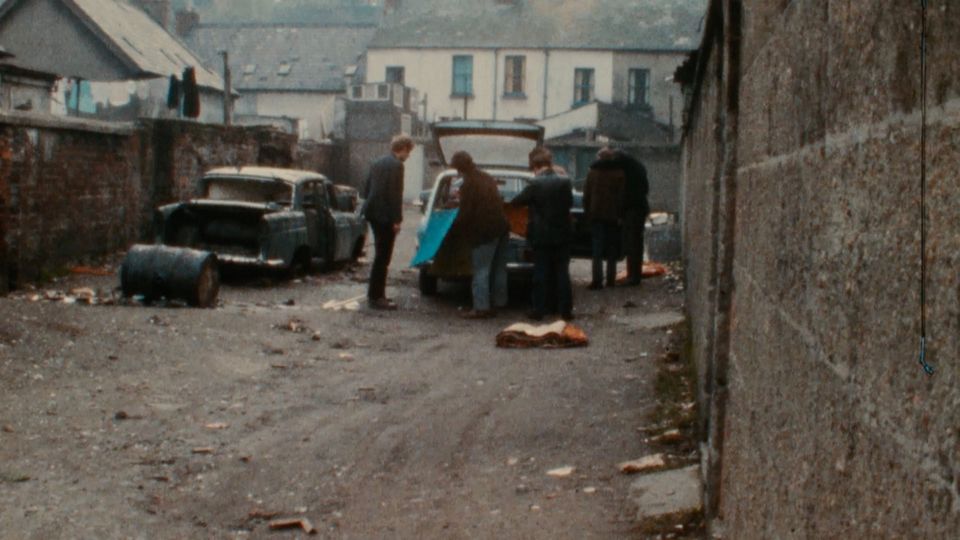
In 1972, an American academic, J Bowyer Bell, secured the IRA’s agreement to participate in The Secret Army, a fly-on-the-wall documentary of its secretive inner workings.
The footage he recorded showed IRA members making bombs, training in how to handle weapons, and exploding bombs in city centres. Unmasked IRA leaders talked openly on camera about the organisation.
As MacIntyre says: “The whole endeavour made very little sense when they knew that intelligence agencies were trying to spy on everything they were doing.”
The existence of the film emerged four years ago, but now far more detail is coming to light.
McGuinness was just 21 in 1972, but already the IRA leader in Derry.
In the film, he drove around Free Derry as a front-seat passenger did the talking.
He said the crew asked McGuinness if he would drive around the area and explain things for the film, to which McGuinness replied: “I’ll only do it if you go with me.”
Devine said: “I think Martin actually asked me to do the talking.”
He told MacIntyre the camera crew “were up our ass no matter where we went”.
They filmed McGuinness showing children guns, loading bullets into a revolver as the wide-eyed youngsters peered excitedly through the window of the car.

McGuinness is seen helping to prepare a car bomb which then explodes in the city centre. At least 26 people were injured in that attack, part of a two-day blitz which left eight people dead.
Des Long, a former army council member who was present when the Provisional IRA was founded in 1969, was filmed openly instructing IRA volunteers in how to use guns.
Long said Bowyer Bell told him he didn’t need a mask because “you’ll be shown from the chest down… that was a verbal promise from him, and it meant nothing”.
He said: “The whole thing was just… it should never have been made; I’m sorry to this day that I ever took part in it.”
Why would the IRA take such huge risks?
One possible motive is that it thought victory was at hand and became overconfident. Another possibility is the need for money. Long said the IRA got much of its funding — “hundreds of thousands” — from America.
In the view of Jacob Stern, who composed the soundtrack, “the purpose of the film was to show the legitimate cause of the IRA”.
Stern said the IRA wanted “more favourable opinion in America… and maybe they could raise more money that way”.
Now 88 and living on the edge of an Arizonan desert, he said firmly: “I was in sympathy with the IRA.”
From the moment Bowyer Bell collected Stern at Dublin Airport, he was using counter-surveillance techniques, telling the composer they were being followed by intelligence agencies, but shaking them off by walking through a shop to another car.
The IRA insisted on controlling the film’s content, telling the filmmakers that if they didn’t comply, they’d be shot.
MacIntyre said he had independently confirmed that Bowyer Bell ceded editorial control to the IRA.
The film glamorised the violence in a way which now seems simplistic.
Geraldine Hughes, a 17-year-old, described it as “a great honour” to be in an IRA active service unit in Andersonstown, and referred to her activities as something which gave her self-confidence: “I found that I am more sure of myself now than I was beforehand.”
However, the most extraordinary element of the story is what happened after the filming was complete.
Bowyer Bell took the film reels to London for development.
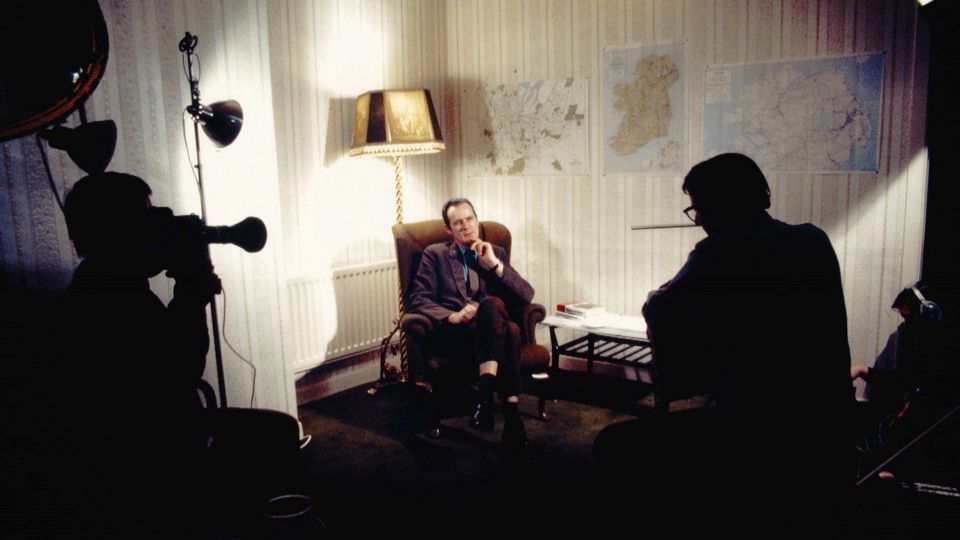
The film’s executive producer, Leon Gildin, said that Bowyer Bell and the film’s director later told him British intelligence viewed the material.
He didn’t blame them for that, assuming they had “no alternative” but to allow the intelligence services to see the reels.
He said: “Had they had developed it in Dublin, perhaps no one would have seen it. By virtue of it being developed in London, that’s where British intelligence got their hooks into it.”
Bowyer Bell’s CV from 1991, tracked down by MacIntyre in a Harvard archive, shows that from 1974 he did work for the CIA, the US Department of Justice, Department of Defense, and State Department.
He had high-level security clearances, cleared to Top Secret for the CIA and Department of Defense.
A long-standing friend, Roberto Mitrotti, said bluntly: “Part of him was pretty s**tty.”
When asked if he was working for the CIA, he said: “I think he was. He was too smart to be a servant of an American agency. So he might have taken money from them at some point to provide certain services, provided the services were in the abstract.
“But he would never, knowing him, I don’t think he would betray; he would sell, people, human beings in the service of the CIA.”
He said: “He was really talking like a CIA agent… he lived it, and he was good at it… he was a character in his own movie.”
Tim Pat Coogan, author of a history of the IRA, said he’d no doubt Bowyer Bell was a CIA agent.
He said: “You wouldn’t know what Bowyer Bell told them; did they think there was going to be a Hollywood bonanza, that money would flow into the coffers?”
However, when Stern was asked if he believed he was inadvertently working with a CIA operative, he said: “Absolutely not.”
Bowyer Bell’s daughter, Becky Waring, also denied he was a spy, but then said: “He probably wouldn’t have told me if he was.”
“I remember us all being very excited — daddy’s going to do a movie. Then we were all waiting for it to be on TV, and it never was; it was a big disappointment.”
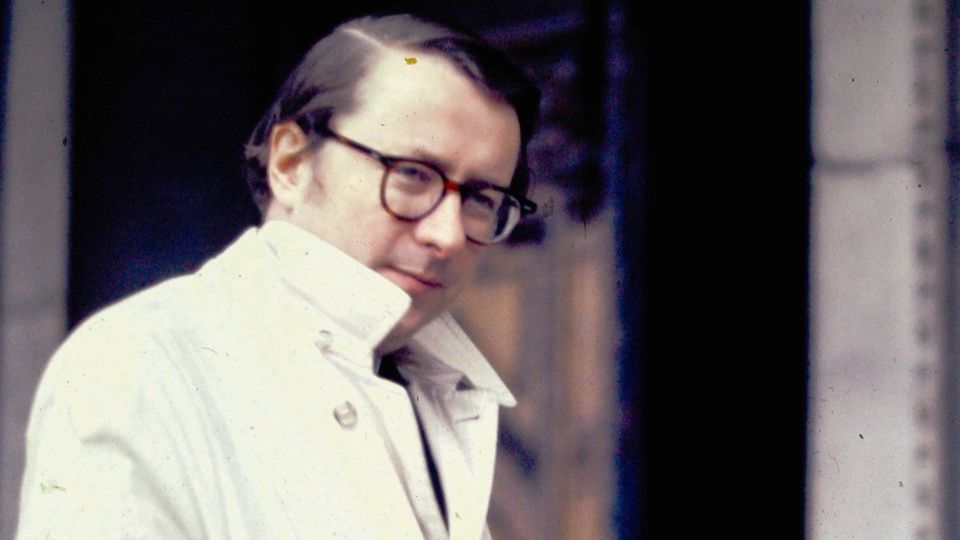
Bowyer Bell’s choice of director for the film adds to the intrigue. He selected Zwy Aldouby, a man who appears to have had no experience of filmmaking. The Israeli writer and journalist had been a Nazi-hunter after the Second World War.
The CIA had been gathering intelligence on him and according to declassified CIA documents he was then working under the guidance of Israeli intelligence.
Aldouby’s son, Illan, said he didn’t really know who his father was.
When asked if it was possible that his father was part of a conspiracy by intelligence agencies to infiltrate the IRA, he said: “I would say there would be a strong possibility. There is a connection of the IRA and Israel, and that connection is Gaddafi… my father, if he worked with or collaborated or worked with the Mossad or Israeli intelligence, it would be a clear fit.”
Richard Kerr, a former deputy director of the CIA who was monitoring Libya from the 1970s, said it was “almost a certainty” that Aldouby was spying on the IRA and feeding that back to Israel.
The film ultimately did get to America where it was Gilden’s job to sell it.
Viacom “loved it”, he said, and “immediately offered me a contract for worldwide rights”.
But having done so, it “never sold a copy”.
Why a company would buy the global rights to a film — preventing anyone else from broadcasting it — but then not sell it adds to the questions around the entire enterprise.
Mitrotti said that Bowyer Bell later told that the British Government scuppered the film by putting pressure on the US Government to keep it hidden.
After looking at Bowyer Bell’s CV, Tony Devine said: “Reading this here… we were idiots.”
For years, there have been claims that McGuinness may have been an informer, but without evidence behind them.
Last year, several former IRA members who served with the Sinn Fein leader in Derry raised questions about key decisions he made.
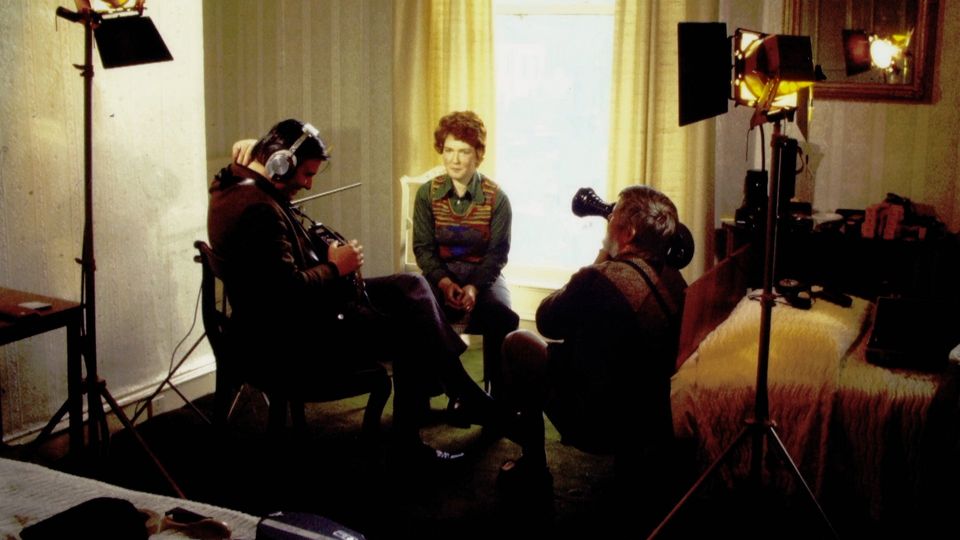
In a book by former IRA man Richard O’Rawe, an ex-IRA commander for north Derry, north Antrim and south Down said he openly accused McGuinness at an internal meeting: “I just came out in front of everybody and said to McGuinness, ‘You’re nothing but a f***ing tout’ and I walked out of the house.”
Five years ago, Willie Carlin, a former MI5 agent within the IRA in Derry who was close to McGuinness, said that he’d seen him at an MI5 safe house in Limavady.
He also said that it was MI5 which acted to protect the senior Sinn Fein figure when, in 2001, Carlin’s former handler came out of retirement in Italy to ask him to give evidence to the Saville Inquiry to dispute the evidence of another agent, codenamed Infliction, that Mr McGuinness had fired the first shots on Bloody Sunday.
However, Carlin said that he did not believe that McGuinness was himself an agent. Rather, he said: “I think the British became aware sooner than the public imagined that here was a man they could do business with.”
The Secret Army is available now on BBC iPlayer and will be shown at 9pm tonight on BBC Two